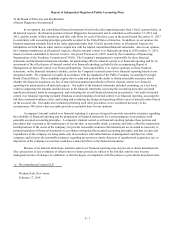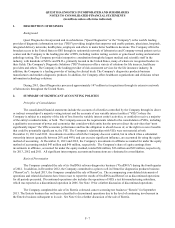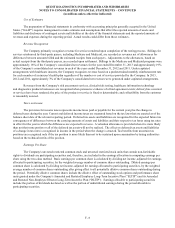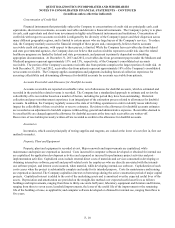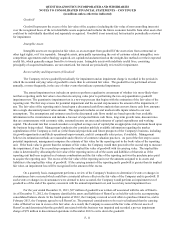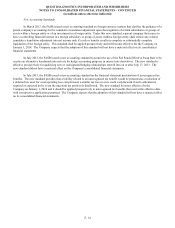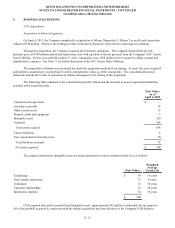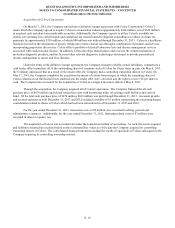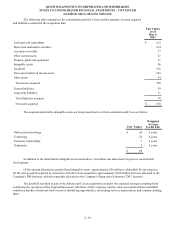Quest Diagnostics 2013 Annual Report Download - page 83
Download and view the complete annual report
Please find page 83 of the 2013 Quest Diagnostics annual report below. You can navigate through the pages in the report by either clicking on the pages listed below, or by using the keyword search tool below to find specific information within the annual report.F- 11
Goodwill
Goodwill represents the excess of the fair value of the acquiree (including the fair value of non-controlling interests)
over the recognized bases of the net identifiable assets acquired and includes the future economic benefits from other assets that
could not be individually identified and separately recognized. Goodwill is not amortized, but instead is periodically reviewed
for impairment.
Intangible Assets
Intangible assets are recognized at fair value, as an asset apart from goodwill if the asset arises from contractual or
other legal rights, or if it is separable. Intangible assets, principally representing the cost of customer related intangibles, non-
competition agreements and technology acquired, are capitalized and amortized on the straight-line method over their expected
useful life, which generally ranges from five to twenty years. Intangible assets with indefinite useful lives, consisting
principally of acquired tradenames, are not amortized, but instead are periodically reviewed for impairment.
Recoverability and Impairment of Goodwill
The Company reviews goodwill periodically for impairment and an impairment charge is recorded in the periods in
which the recorded carrying value of goodwill is more than its estimated fair value. The goodwill test is performed at least
annually, or more frequently, in the case of other events that indicate a potential impairment.
The annual impairment test includes an option to perform a qualitative assessment of whether it is more-likely-than-
not that a reporting unit's fair value is less than its carrying value prior to performing the two-step quantitative goodwill
impairment test. The quantitative impairment test is a two-step process that begins with the estimation of the fair value of the
reporting unit. The first step screens for potential impairment and the second step measures the amount of the impairment, if
any. The fair value of the reporting unit is based upon a discounted cash flows analysis that converts future cash flow amounts
into a single discounted present value amount. This approach includes several unobservable inputs related to our own
assumptions. The assumptions and estimates used in the discounted cash flows model are based upon the best available
information in the circumstances and include a forecast of expected future cash flows, long-term growth rates, discount rates
that are commensurate with economic risks, assumed income tax rates and estimates of capital expenditures and working
capital. The discount rate that is used considers a weighted average cost of capital plus an appropriate risk premium based upon
the business being valued. Management's analysis also considers publicly available information regarding the market
capitalization of the Company as well as (i) the financial projections and future prospects of the Company's business, including
its growth opportunities and likely operational improvements, and (ii) comparable sales prices, if available. Management
believes its estimation methods are reasonable and reflective of common valuation practices. As part of the first step to assess
potential impairment, management compares the estimate of fair value for the reporting unit to the book value of the reporting
unit. If the book value is greater than the estimate of fair value, the Company would then proceed to the second step to measure
the impairment, if any. The second step compares the implied fair value of goodwill with its carrying value. The implied fair
value is determined by allocating the fair value of the reporting unit to all of the assets and liabilities of that unit as if the
reporting unit had been acquired in a business combination and the fair value of the reporting unit was the purchase price paid
to acquire the reporting unit. The excess of the fair value of the reporting unit over the amounts assigned to its assets and
liabilities is the implied fair value of goodwill. If the carrying amount of the reporting unit's goodwill is greater than its implied
fair value, an impairment loss will be recognized in the amount of the excess.
On a quarterly basis, management performs a review of the Company's business to determine if events or changes in
circumstances have occurred which could have a material adverse effect on the fair value of the Company and its goodwill. If
such events or changes in circumstances were deemed to have occurred, the Company would perform an impairment test of
goodwill as of the end of the quarter, consistent with the annual impairment test, and record any noted impairment loss.
For the year ended December 31, 2013, $37 million of goodwill was written-off associated with the sale of Enterix.
As of December 31, 2012, the Company classified the assets and liabilities of HemoCue as held for sale in the accompanying
consolidated balance sheets. In the fourth quarter of 2012, the Company received several offers to purchase HemoCue, and in
February 2013, the Company agreed to sell HemoCue. The proposed consideration to be received indicated that the carrying
value of HemoCue was in excess of its fair value. As a result, the Company re-assessed the fair value of the net assets of
HemoCue and determined that the goodwill associated with this business was impaired and recorded a pre-tax impairment
charge of $78 million in discontinued operations in December 2012 to write down the goodwill.
QUEST DIAGNOSTICS INCORPORATED AND SUBSIDIARIES
NOTES TO CONSOLIDATED FINANCIAL STATEMENTS – CONTINUED
(in millions unless otherwise indicated)


